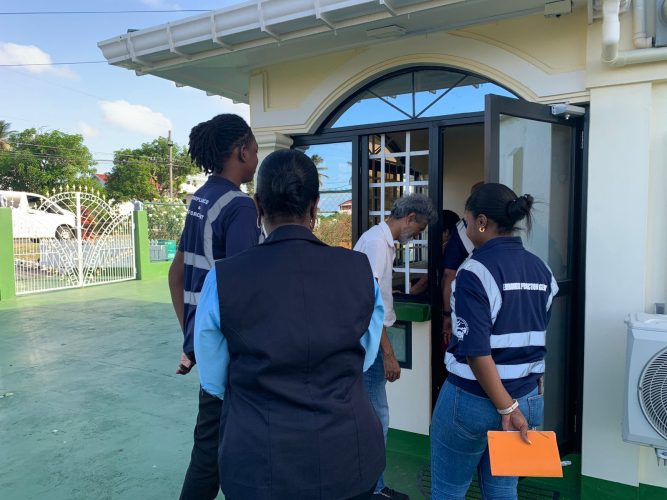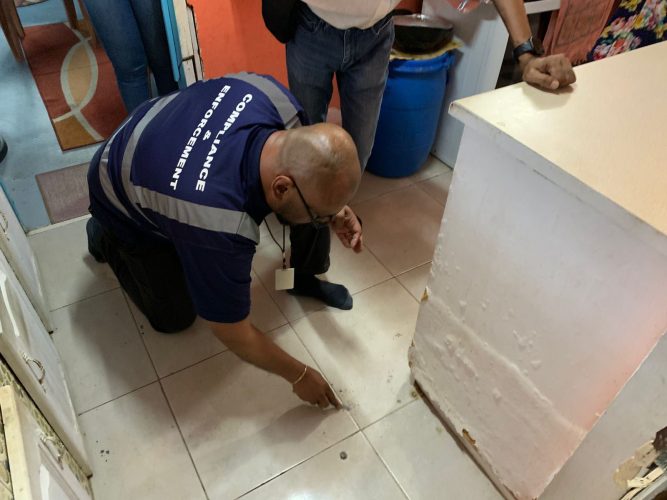The Environmental Protection Agency (EPA) yesterday revisited Crane on the West Coast of Demerara for more sampling of a mysterious substance that has been oozing in several houses.
November 3 marked exactly one month since the appearance of a substance which has since been described by the EPA as “some type of hydroxide”. Despite the attention of the EPA, which has made repeated visits to the affected areas, the substance’s origin and composition remain unresolved. Recent developments reveal a complex investigative process and an array of theories, but no definitive conclusions have been reached.
During a visit to Crane yesterday, Kemraj Parsram, Head of the EPA, and EPA chemist Patrick Ketwaru led a team to further investigate the homes affected by the substance. According to Ketwaru, the emergence of the substance has been erratic and unexplained. “What is strange is that the emergence is periodic,” Ketwaru said. “You can’t relate it to anything like rainfall; it just appears at random intervals.”


The EPA has been studying the substance in hopes of determining its origin and composition. Preliminary tests have ruled out hydrocarbons, but small amounts of calcium hydroxide were identified. However, Parsram noted that the sample quantities collected so far are too small to enable a full analysis, thus complicating efforts to reach a conclusion.
To enhance data collection, the EPA has taken additional samples from the home of Priya Singh the other affected resident to be analyzed and shared with the Pesticides Board and IMEX Environmental Services, a local testing facility. As part of a new strategy, the EPA will leave monitoring equipment in the home of Basmatie Singh for several days to collect data on the substance and better understand its patterns. Parsram explained, “We will place equipment here to continue testing and check it daily. Hopefully, this will provide more clarity on what is causing the substance to emerge.”
The EPA’s analysis has led to a working theory involving “efflorescence” which according to Ketwaru is a phenomenon where moisture penetrates concrete or tiles, dissolving calcium ions, which then rise to the surface as hydroxide when they react with water.
ExxonMobil Guyana Limited, was also involved in the investigation. It ruled out any connection between the unknown substance and hydrocarbons. The company also pointed out that its Gas-to-Energy pipeline project, still under development, is not operational.
According to Ketwaru, EPA teams performed multiple tests, including pH tests, which indicated high alkalinity. Additional tests confirmed that the substance contains hydroxide. Parsram emphasized that the detected levels of hydroxide are low and thus not hazardous, though residents reported discomfort.
Since the initial visit to the home of Basmatie Singh, she has expressed ongoing frustration. “When I come in here, I still getting this high scent of gas; my skin burns. I’ve lived here for 17 years, and this was never an issue. Why is this happening now?” she asked. In response, Parsram advised residents to avoid the affected areas for safety.
Despite assurances, residents continue to report symptoms, particularly skin and respiratory irritation. Singh recounted that even her sister, who was visiting from Canada, immediately began to choke upon entering the affected area yesterday.
During yesterday’s visit, no visible trace of the substance was observed on the concrete floors, following the removal of tiles in the affected areas. Parsram remarked, “The area was dry when we arrived today, with no new signs of the substance. This means we may need to broaden the investigation to include neighbouring houses, especially as we have heard other residents may be experiencing similar issues, although they have yet to come forward.”
While the EPA’s efforts continue, residents remain anxious for answers and according to Basmatie Singh, she will be considering sending a sample of the substance overseas for an independent investigation. She questioned whether excavating and replacing the tiles might be a solution. Parsram responded, “That’s up to you, but we’re asking for a few more days to observe and see if more of the substance emerges.”
Basmatie Singh added, “We just want to understand what’s happening. They’re saying its hydroxide, but why is it appearing now? How do we get rid of it?”
And with yesterday being her 62nd birth anniversary loved ones who visited had to spend the day with her in her backyard. The EPA has committed to concluding the investigation as soon as possible but has not provided a firm timeline.





